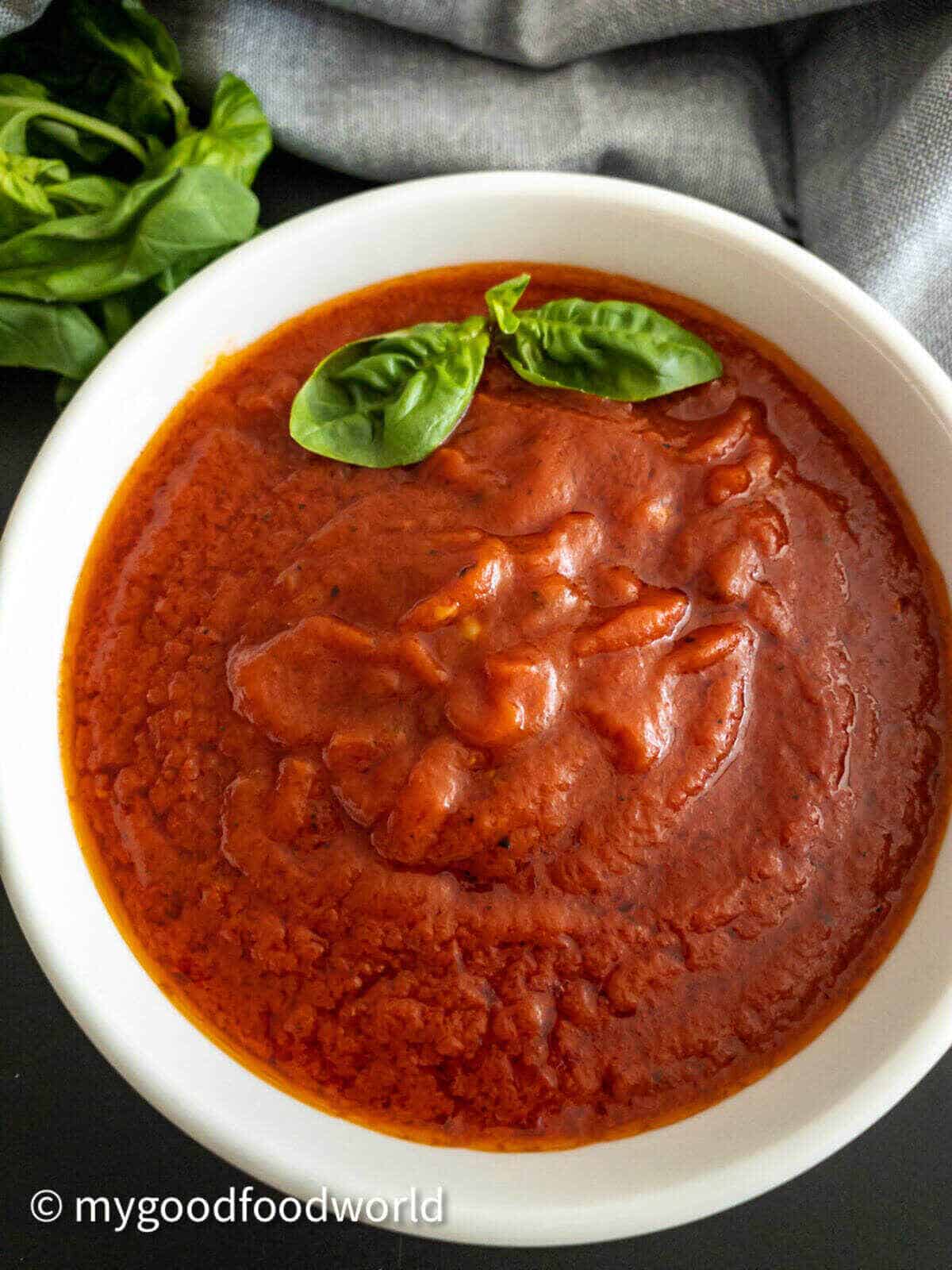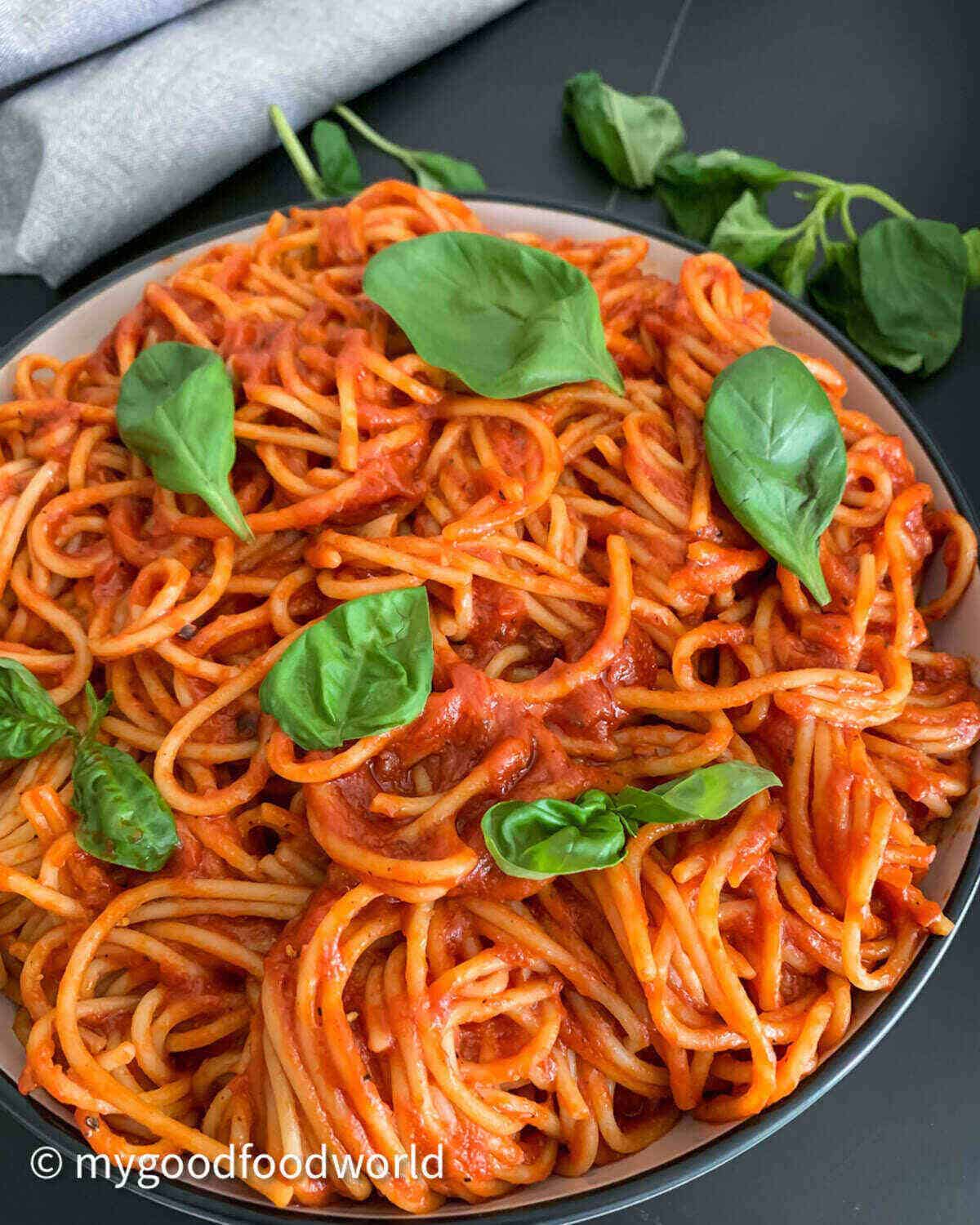What I love about this homemade marinara sauce is that it requires no chopping (yay!), uses simple pantry ingredients, can be made ahead, and, like this vegan pesto, keeps well in the fridge for days! It’s also incredibly versatile. I use it as a sauce for pasta (of course!), pizza, and lasagna. It also works well as a dipping sauce. It is kid-friendly too! Sounds perfect, doesn’t it?! And it is. Keep a jar of this hearty marinara sauce in the fridge, and trust me, it’s a lifesaver on busy weeknights—just like how my homemade pesto makes this pasta al pesto come together in a matter of minutes. Make delicious tri-color lasagna with a layer of my Alfredo sauce without heavy cream, a layer of this marinara sauce, and the third layer of my lush spinach pasta sauce. Any doubts or questions? Feel free to ask via the comments below. I will try my best to answer them for you. - Padma Marinara is almost always a quick-cooked sauce and is served with pasta. The classic version is flavored with olive oil and garlic, though some variations include onions for added flavor. Traditional marinara sauce is made with fresh tomatoes—typically San Marzano tomatoes, found in the Campania region of Italy. In the traditional method, the tomatoes are crushed and then cooked with olive oil, salt, black pepper, garlic, and fresh herbs. The sauce is simmered until the tomatoes soften and develop a deep umami flavor. It’s usually left chunky (which is why it’s often called hearty marinara sauce). My recipe deviates from the traditional in two ways: 1) I use passata instead of fresh tomatoes because my dislike for chopping vegetables is no secret (just check out my sauteed okra recipe for proof!), and 2) I add baking soda to speed up the cooking process. There you go, I’ve revealed my second hack! Even though my marinara sauce isn’t chunky, it’s still rich, full of deep flavors, and hearty all the same!
grain-free soy-free dairy-free
Do check the label of soda bicarb, if using, to make sure that it is gluten-free. Disclaimer: Our content aims to be informative and educational, but it should not replace professional medical advice. Since manufacturing processes can vary and cross-contamination is possible, it’s essential to verify product labels and allergen information. Make sure all ingredients align with your specific allergies. As readers, you bear the responsibility for ensuring allergen safety when buying or consuming foods. Passata: I use unflavored tomato passata for this recipe. Known as tomato puree in the U.S., passata is uncooked tomatoes that have been liquefied and sieved to remove any chunks, seeds, and skin. Extra virgin olive oil: Which Italian recipe is complete without it?! Garlic: This sauce needs just that little hint of garlic. You can, of course, use as much garlic as you like - more or less than what I have mentioned. Fresh basil: Fresh, without a doubt. I do not recommend dried basil for this recipe. Bicarbonate of soda: Also known as soda bicarb or cooking soda. This is the secret ingredient that makes this a quick recipe. Ground black pepper: Freshly ground black pepper will taste the best. You can use red pepper flakes instead if you prefer. Or use both if you like it more spicy. Soda bicarb helps cut the acidity of the tomatoes and gives the sauce a balanced taste. If you choose not to use this ingredient, then bear in mind that you will need to cook the tomatoes for an additional 10-15 minutes to get rid of the acidity in the tomatoes. If you have any questions regarding these ingredients, feel free to ask in the comments section below and I will try my best to answer them for you.
Instructions
Making this sauce is not difficult at all and you will be so happy with the results! This is one of those recipes that just come together on their own - no need to fuss over them!
a ladle a chopping board a knife storage box or glass jar for storing the sauce
Let’s learn how to make this hearty marinara sauce. Prepare the ingredients: Finely chop the garlic. Separate basil leaves from the stems. Finely chop the stems. Measure the remaining ingredients and keep them ready. Make the marinara sauce: Place a heavy-bottomed saucepan on low heat. Add the olive oil, followed by the chopped garlic. Over medium heat, as the garlic begins to sizzle in the oil, pour in the passata. Add salt and black pepper. Mix well, turn up the heat, and bring the sauce to a lively simmer. Let it cook for 15 minutes until the sauce reduces and thickens slightly. Now, stir in the bicarbonate of soda and finely chopped basil stems. Simmer for another 2-3 minutes. Mix and simmer for another 2-3 minutes. To finish, tear the basil leaves with your hand and add them to the sauce. When added to the sauce, soda bicarb will froth up—don’t worry, that’s normal. Just stir it in well and continue cooking as instructed. Once the frothing settles and the sauce cooks a bit more, you’ll notice that the acidity is gone, leaving you with a deliciously rich tomato flavor! Your sauce is ready! Toss it with pasta or use it as a dip. Enjoy! Fresh tomatoes: You can use fresh tomatoes instead of passata, but keep in mind this will increase the overall cooking time. Pasta: Any pasta works great with this sauce. I’ve used spaghetti the most, but penne and fusilli work just as well. The sauce is versatile—you can use it as a pizza sauce or even as a layer in lasagna. For the best flavor, sprinkle your pasta with your favorite cheese, or if you’re keeping it vegan, try some nutritional yeast flakes. Amp up the flavor by adding any or all of these to the sauce:
Add 1 small onion, finely chopped, after adding the garlic. Add 1 green bell pepper, finely chopped just after the onions have sauteed. Use dried or fresh oregano instead of or in addition to basil. If you are ok with dairy, add your favorite cheese. To make it Domino’s style hearty marinara sauce, add 1 tablespoon of tomato paste (concentrate).
High-quality tomato puree is key here. Lower-quality ones can be thin and lack flavor. For this recipe, you want a puree that tastes like real tomatoes! Stick to plain, unflavored puree for the best results. Don’t skimp on the oil. It not only adds flavor but also acts as a preservative. And yes, extra virgin olive oil only please! Keep an eye on the garlic—don’t let it turn brown. Even the tiniest bit of burnt garlic can ruin the taste of the sauce. For the best flavor, always use fresh basil.
If you have enjoyed reading this, please take a moment to leave a comment and a rating below. This will motivate me to create more good content for you! You can also engage with me on Twitter, Facebook, and Instagram. - Padma Freezing the sauce: This sauce is perfect for batch cooking! Once cooled, store it in freezer-safe containers or bags and freeze for up to three months. Reheating: To reheat from the fridge, place the sauce in a saucepan and bring it to a gentle boil over medium heat. If reheating from the freezer, you can either thaw the sauce in the fridge overnight and reheat as described above, or place the frozen sauce directly in a pan and heat it on medium until warmed through.
📖 Recipe
Disclosure: The nutritional information is calculated using an online calculator and is based on available ingredients and preparation. It should not be considered a substitute for a professional nutritionists’ advice. Changing the quantities and cooking technique will alter the nutritional calculations.










